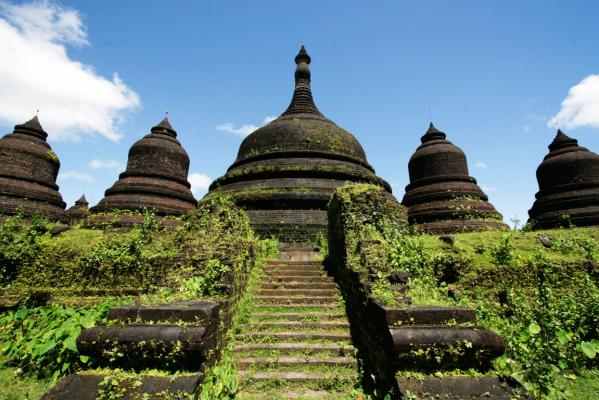 Tattoos and temples
Tattoos and temples
Article by: Burma Traavel
December 08, 2013
Our passage up the swollen coffee-coloured waterway has sputtered to a halt.
The boatman gives the long-tailed outboard motor a bang or two with a lump of wood, and we are now at the mercy of the river.
The Lemro River, fattened by the monsoon rains, flows through Chin State and Rakhaing State in western Myanmar (formerly Burma).
My travel companion and I had hired a boat from the village of Mrauk U to visit the remote Chin villages scattered along the Lemro's banks. The sleepy villages are home to the some of the last tattooed women of the Chin tribe.
We had been making slow steady progress in a long wooden boat against a strong current, watching as bamboo traders floated past in the opposite direction at a rate of knots. The bamboo they plan to sell has been lashed together to also provide a means of transport.
On the banks, women sit on their haunches slapping the daily washing on a purposely-positioned log or fortuitously fallen tree. As a woman holds up a light-coloured garment it holds the latte hue of the giant laundry tub from which it has emerged.
Men and boys, still wearing their longyi (a traditional wrap-around skirt), scrub themselves clean while young children flashing bright smiles from the windows and doorways of wooden villages, wave energetically.
The motor on our boat coughs back to life but there is not enough air in its lungs to run any further up river. With just enough power to steer our stricken vessel, the boatman turns the bow around and we ride the current to one of the Chin villages we passed earlier.
We disembark on to the stony shore and follow our guide Myint Zaw towards the edge of a forest that sits back from the water.
As we enter the village, a blanket of humidity replaces the cool breeze we felt from drifting on the river.
A large pig snores in the dirt beneath a stilted house while a family congregates on the earthen yard. The youngest child is peeling a grapefruit with eager anticipation, a teenage boy weaves a hat from fronds of a palm and the father savours the flavour of a cheroot as he welcomes us with a toothy smile between puffs.
In the village square, a swarm of children jump and run for our amusement. From one of the wooden homes two elderly women emerge and the dappled light highlights the blue spider-webs inked on their wrinkled faces.
These are the tattooed women of the Chin tribe.
The tradition of facial inking ceased several generations ago and only a handful of women now carry the tribe's unique heritage.
Legend states the beauty of Chin women led them to be carried off by Burmese kings so they began the practice of tattooing their faces to deter the unwanted advances of Burmese royalty.
The truth may be the markings were considered a stamp of womanhood and attractiveness.
The intricate patterns on the weathered skin of these graceful women lures a small number of tourists to a remote part of western Myanmar and provides an economic lifeline for their villages.
There is no electricity or running water and donations left by visitors buy medical supplies and help build and run schools like the one we are invited to poke our heads into.
While incomplete, it resonates with the singsong of A-B-Cs and chanting of mathematics tables.
When we return to the boat, a villager has donated a second small motor to our boatman so we navigate further back down the river under slightly more power and direction.
We anchor on the muddy banks of the Lemro and follow a path into another Chin village.
Amidst a pile of citrus fruit sit several grey-haired tattooed women. Decades of chewing on betel nut, a natural stimulant, has left their lips and the few remaining teeth in their mouths stained blood red.
Nearby, a woman pounds cumin seeds into powder in a hollowed-out log. Moments later the drumming of her labour is drowned by a tropical downpour.
The path we followed into the village has become a gushing torrent for naked children to splash and play in.
Chugging back to Mrauk U the storm clears and I ask Myint Zaw if the old women mind being the centre of attention for the relatively few tourists who come to see them.
He says that while they are private people, they understand their unique looks can improve the quality of life for their families and others in the villages. But soon they will be gone, Myint Zaw reflects.
Mrauk U is an ancient kingdom now disguised as a village in the remote hills of the southwestern Rakhaing State near the Bangladesh border.
Hundreds of temples scattered around the hills, resting in fields and tangled in jungle vines make it a playground for any Indiana Jones wannabe.
It's a timeless place where the sun rises and sets over 700 thick fort-like temples. From 1430 to 1784, the city served as the capital of the Rakhaing people - an ethnic group still in the area.
Reaching Mrauk U is an adventure in itself.
Virtually cut off by road, access from the rest of the country is by plane through Sittwe, a faded port city on the Bay of Bengal, and then a ferry loaded with people, animals and supplies that sails up the Kaladan River.
A trip to the ferry toilet facilities (a partitioned hole in the deck) involves climbing over a mountain of onion-filled sacks and sidestepping a pile of live chickens.
Before dawn breaks over Mrauk U, I scramble up through vegetation still wet with dew to reach a small temple on a hillock.
Perched on the moss-covered bricks I watch the sun's first rays burn away the mist and reveal an ancient kingdom filled with temples. As the sun climbs higher, the kingdom begins its transformation into a village where goat herders, farmers, shop-owners and monks stir to life.
The temples can be explored on foot or by bicycle and are deserted with the exception of an occasional animal.
Mrauk U's largest temple and its outer passageway is lined with thousands of bas reliefs and Buddha images. The silence is broken by the bleat of a goat as it scales the walls to feed on the weeds growing between the stones.
Down the dusty road Peisi Daung Paya hides beneath the undergrowth. Parting the curtain of leaves and cobwebs reveals a Buddha gazing out from his crumbling cloister.
In the cooling afternoon, standing on the outer walls of Shittaung Paya, it's easy to understand why Mrauk U is so special.
It is more than a historical site.
The ruins are a backdrop to everyday life for the villagers and farmers. Young boys herd their goats and cattle between the stupas. Women balance shiny aluminium pots on their heads, carrying water home from wells built beside the temples.
Young boys wrestle on the warm stone slabs of the pagoda before bursting into a fit of laugher and running off to play elsewhere in their ancient playground.
Source: http://www.stuff.co.nz/travel/destinations/asia/9494473/Tattoos-and-temples
Login to comment
Comments
No comments yet.

